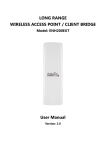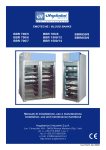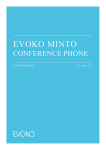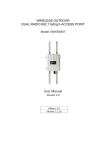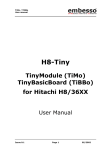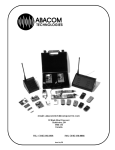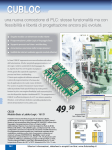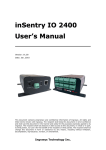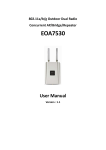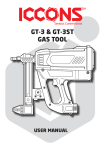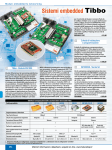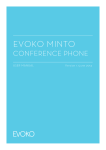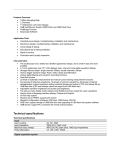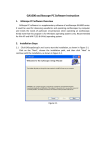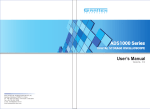Download AMMS Product Introduction and Background
Transcript
1 Alert Monitoring and Management System Software Application Product Introduction Willabay Design, LLC Version 2.0: November 18, 2012 Updated Version 4.0: April 26, 2015 Introduction As part of its entry into the environmental monitoring software business, Willabay Design LLC is offering a software package for Tibbo processor modules which will allow these processors to function as a web server for security systems and sensor systems. This will allow almost any hardwired alarm system, environmental sensor, or alert system to have their outputs viewable and reported over the internet. In a typical application, the need for auto-dialers or a service-based alarm reporting system is replaced by a single web server that can support up to 32 separate alerting inputs at once. This Alert Monitoring and Management (AMMS) application utilizes a dedicated wired network access connection or 802.11(g) Wi-Fi access to a router. It is also free of any monthly service fees since it is not managed by an alarm service. The software for this application has been designed for the Tibbo line of programmable devices which are made by Tibbo Technologies in Taiwan. The application is written in Tibbo Basic, a language well suited for applications such as this on embedded processor platforms. Willabay Design offers the object code binary for this application and not the source code which is proprietary and copyright protected. This software will not be available on an open systems basis because it is a security product that demands a very high degree of reliability. This initial offering of the AMMS application was supported on two Tibbo programmable modules; the term Tibbo uses for the small devices that contain their microprocessors. One was the Tibbo EM1000 module, with or without an attached 802.11(g) wireless access device. The second Tibbo programmable module was the EM1202 module. Willabay Design did not offer a wireless build option for the EM1202 because there was no Tibbo board or controller that supported that module with Wi-Fi at the time. Tibbo did offer a board based product called the EM1202EV-TM that contained the EM1202 module and supported up to 8 I/O lines. Product History The AMMS application was initially designed to be compatible with several existing board or controller hardware platforms. One of these was an Abacom 32IOSERVER hardware platform that uses a Tibbo EM1000 embedded module for web access. Abacom 2 is a Canadian company that designed their own EM1000 based board. The second platform is a Tibbo DS1005 controller which is based on the same Tibbo EM1000 embedded module but uses Tibbo’s own internal NB1000 board. The DS1005 supported 8 input lines and 6 output lines. The third platform is Tibbo’s EM1202EV-TM board which has an available interface header that supports 8 input lines. After subsequent testing on each of these platforms, Willabay Design decided to focus the actual introduction of their product line on Tibbo’s set of controller devices; platforms that a customer could order without having to provide their own enclosure or board design. While the Abacom device was available in an enclosure, it could not support Tibbo’s Wi-Fi device (GA1000) in the same enclosure. By early 2014, the only hardware device that Willabay Design officially supported for the AMMS was the DS1005 Programmable Controller. Field trials using the same NB1000 board that Tibbo uses in the DS1005 were run continuously in several locations from 2013 to early 2015. A newer version of this controller, the model DS1015, has built-in Wi-Fi access that can also support this application. In late 2014, Willabay Design started to test the AMMS application on Tibbo’s Tibbo Project System (TPS), a very innovative modular product that allows hobbyists and kit builders to build their own electronic projects using a Tibbo module based circuit board and any of many various add-on devices called Tibbits. While the AMMS will eventually be supported on either the TPP2 or TPP3 based platforms, Willabay Design has concentrated on the TPP2 version for their first TPS based applications. Other Tibbo devices such as the newly introduced EM1001 may also be supported in the future. AMMS Development on Future Tibbo Platforms When Tibbo introduced their TPS system in 2014, Willabay Design recognized that the kit based modular platform provided an excellent way to offer the AMMS application at a cost that was significantly lower than any previous Tibbo device that supported the same number of lines. In addition, the Tibbit concept allows one box to support a wide variety of inputs or outputs. The TPS concept is so unique and attractive for a wide variety of customers that we are going to concentrate all future AMMS development at that platform. At the same time, we will continue to support the AMMS application on the DS1005 platform because it is an extremely robust, industrial strength device that can be used in applications that require a weather-proof platform. We are recommending that our readers check out Tibbo’s website at http://www.tibbo.com/tps for further details on the TPS system. This document, as well as other Willabay Design documents that reference the TPS, assumes that the reader is familiar with the basic TPS concept and TPS terminology. In order to support a wide variety of Tibbit modules on one TPP2 platform, Willabay Design found it necessary to enhance some of the configuration aspects of the AMMS Copyright 2015, Willabay Design, Williams Bay, WI 3 system. A key addition to the original software design was a change that allowed the system to support I/O Tibbits that have fewer than 4 input or output lines. The original AMMS system was designed with a minimum line assignment of 4; a concept called a Monitor Group in the detailed documentation. Once this enhancement was complete, a basic TPP2 based AMMS product can support up to two full input ports (16 lines) and one output port (limited to 4 lines) in a very inexpensive box. The availability of a very nice LCD display on the TPP2 was a significant extra capability that will be used in the next release of this AMMS product. Willabay Design will also expand this support of the TPS to the TPP3 platform in the very near future. This application does not support any functionality over serial ports at the present time. All input connections are digital I/O inputs. In the TPS case, the product can be configured with other Tibbit modules for such things as Wi-Fi support, optional power adaptors, and potentially directly connected environmental sensors. The present AMMS software can easily support the addition of a GA1000 Wi-Fi device and its antenna. All Tibbo devices are manufactured by Tibbo in Taiwan. The 32IOSERVER and other Tibbo products are available from Abacom Technologies in Canada. http://www.abacomtech.com. The US distributor of Tibbo products that Willabay Design has used for Tibbo product purchases is the Microcontroller Pros Corporation (http://www.microcontrollersshop.com). Just prior to the current release of the AMMS application, Tibbo has announced a new processor board called an EM1001 Based on the cost of this board, it appears that this board may also be an excellent basis for Willabay Design’s AMMS and EDMS applications. Further information on planned support for the EM1001 will be available later in 2015. Introductory Platforms and Field Trials An early Willabay Design test platform for the Abacom 32IOSERVER board is shown in Figure 1. An internal view which exposes the internals of the platform is shown in Figure 2. Copyright 2015, Willabay Design, Williams Bay, WI 4 FIGURE 1 FIGURE 2 Abacom Board Test Platform This Abacom based test platform used Elexor IO cards for all input and output connections. Depending on the source hardware that the server is monitoring, external cards like these Elexor cards may not even be necessary. The Abacom board design directly exposed the EM1000 lines on four board connectors. As long as the connected device is compatible with the Abacom 32IOSERVER, the Willabay Design software will work. This test platform arrangement was not offered as an end product. As of early 2015, it is not clear if Abacom will continue to offer their own board. As such, Willabay Design will only support the AMMS for this platform on a OEM basis when requested by an Abacom customer. On several of Tibbo’s hardware platforms, access to the web server may be via a dedicated Ethernet line to an Ethernet port on a router or via an 802.11(g) wireless network connection to a wireless router or AP which connects directly to the optional wireless access device called a GA1000. The GA1000 is also manufactured by Tibbo. The Tibbo DS1005 Digital IO Controller version of this application uses the same Tibbo Basic application but is configured to run on the NB1000 Tibbo board that hosts the EM1000 module on the DS1005. Willabay Design had initially tested this application on a stand-alone NB1000 board thus the application will run on the stand alone board or the full controller product. Tibbo uses a different NB1010 board on its DS1015 controller; the Wi-Fi version of a DS1005. Willabay Design can easily generate an upgrade to support the DS1015 if there is a market for this option. Figure 3 shows a test configuration using the Tibbo NB1000 board, one Elexor input card, and one Elexor output card. This test platform utilized a custom designed I/O interface card to allow the Elexor cards to be connected to the NB1000. Copyright 2015, Willabay Design, Williams Bay, WI 5 FIGURE 3 - Tibbo NB1000 Test Platform Documentation on the standard Tibbo DS1005/DS1015 controllers can be found on Tibbo’s website at http://tibbo.com/products/controllers/ds10xx/ds10x5. The DS1005 controller is shown in Figure 4. Note that Tibbo has released a number of similar controllers but the DS1005 and DS1015 Digital IO Controllers are the only ones applicable to this Willabay Design software package. FIGURE 4 - DS1005 (From Tibbo Website) The initial Willabay Design wireless test prototype setup is shown in Figure 5 below. This testing arrangement used a Tibbo NB1000 board to emulate a DS1015 before Tibbo actually released the product. Note that the Ethernet cable connection is only for program update purposes. All normal access is via the GA1000 wireless module on the Tibbo EM1000. Additional details on this field trial configuration are provided in the Product Trial Configuration later in this document. Copyright 2015, Willabay Design, Williams Bay, WI 6 FIGURE 5 - Full Prototype Wireless Trial Configuration Web Server Application Functions and Components Network and Internal Features In addition to providing full web access to the AMMS configuration and alert status information, the web server is capable of sending email to multiple email addresses (up to 3) in the event an alert is detected on the device. The system can scan for alerts on up to 32 input lines; depending on the platform that is used. Emails are sent within 15 minutes of detecting an alert condition; an interval which is very well suited to applications such as temperature monitoring for sub-freezing conditions. There is also an alternative scan frequency option that will allow the server to scan for events every 5 minutes but report an alert via email only if the detection frequency over this interval is above a specified threshold. This special case is called the FASTSCAN mode. Only 8 input lines can be scanned at this frequency. The Alert Monitoring and Management System is not intended for emergency notifications such as the detection of the activation of a smoke alarm. The reason for this is that alert activations are not detected immediately but are normally detected within 15 minutes (A 5 minute option is provided). The control software that monitors for alert conditions has also been designed to remain operational under very extreme conditions. These include, but are not limited to, cases where every alert in the system has been activated. The application will also be active after a power failure and will function normally if the hardware is running on backup power. As long as the hardware platform is powered up, the system’s program will operate and will monitor its network connections continually for any malfunction. Automatic recovery procedures have been designed to insure that Copyright 2015, Willabay Design, Williams Bay, WI 7 the server will eventually recover from such events as a router reboots, email server connection failures, or lost connections to the appropriate Domain Name Server. The AMMS application supports internet access to a router using DHCP or via an assigned static IP addresses. In addition, the Wi-Fi access side of the system (if equipped) can support its own static IP address; even if a wired IP connection is present. DHCP is not supported on the Wi-Fi connection. The system uses a proprietary interface to Tibbo’s WLN Library for this Wi-Fi access. While the availability of a wireless connection using devices such as web cams has often been questionable, Tibbo Technologies has created a “keep alive” set of functions for their devices which will insure that the Wi-Fi connection remains up at all times. Between this Tibbo code and the on-board recovery software designed by Willabay Design, all of our wireless test platforms have remained operational throughout their trial periods. Line Assignment Detail The Abacom 32IOSERVER, or Tibbo NB1000 board is comprised of the server board with up to 4 input ports, each of which support eight 3.3 volt input lines. The set of inputs is internally managed by the AMMS on the basis of a minimal set of 4 inputs per source called a Monitor Group(MG) . There can be one or two MGs per port. One server can thus support from 4 to 32 separate inputs in groups of 4. The application on either platform allows for up to 4 ports any one of which can be an output port. The basic system can also support all 4 ports for input. The design requires all input triggers to be the same; i.e. all active HIGH (N/C) or LOW (N/O). Only one output port with 8 output lines is supported at this time on either of these hardware platforms. By comparison, the EM1202EV-TM device that was used in early testing was limited to 8 input lines in one port and no output port. The DS1005/DS1015 Digital IO Controller versions of this application supports up to 8 inputs and 6 outputs as specified in the Tibbo documentation. Any input line voltage detected by the DS1005/DS1015 is considered a LOW input by the Willabay Design server application. The DS1015 product utilizes a slightly different NB1010 board which has not yet been tested but is functionally equivalent to our NB1000 based field trial platform. If an OEM vendor supplies the necessary connector mapping interface, this application can also be used on the Tibbo NB1000 or NB1010 boards in a separate OEM package. Line assignments on the Tibbo TPP2 version of the TPS platform are entirely based on the board position that the various Tibbits are placed. Tibbo calls their board position a Socket and up to 2 Sockets can be placed as a pair on what Tibbo calls a Tile. This aligns nicely with Willabay Design’s notion of a Monitor Group. The actual number of lines used is totally dependent on the specific Tibbit that is placed on a particular Socket. The Copyright 2015, Willabay Design, Williams Bay, WI 8 initial AMMS release on the TPP2 will support any of Tibbo’s currently available Input or Output Tibbits. In fact, the internal line assignment is driven directly by the Tibbit number. If a user attempts to configure (on the Tibbit Setup Page) a Tibbit that is not allowed, it will be rejected. Note that it is a very good idea to predefine a Tibbit configuration in the software before the actual Tibbit is plugged into the board. Willabay Design Software and Operating System The software that was designed for this application is essentially its own operating system. Because of real time constraints associated with security devices of this type, it was not realistic to design the application on top of some existing software platform. As such, the task scheduling, I/O detection, and alert reporting functions are entirely new functions that will remain Willabay Design proprietary software. This software carries a registered US copyright and cannot be used in any other devices. A portion of the operational aspects of this product uses code originally written by Tibbo but modified for this application. This includes the DHCP, DNS, and SMTP software that is used in this product. Willabay Design may be able to support a limited amount of custom modifications to the basic application which is entirely written in Tibbo Basic and HTML. Any such support will be on a contractual OEM basis. Many of the functional interfaces such as the SMTP, DHCP, DNS, and wireless access interfaces are based on available Tibbo code that was utilized for this application and modified accordingly. One of the key advantages of the Tibbo embedded processor product line is the ease of which applications can be developed for the family of processors. Tibbo is now supporting WPA1 and WPA2 Wi-Fi security on their products in addition to WEP security. Willabay Design can therefore offer this product in such a way that users can connect to any wireless router using WEP (64 bit), WPA1-PSK, or WPA2-PSK Wi-Fi security modes but only with 64 bit encryption. WEP128 has not been implemented at the present time. There are some built in restrictions imposed by Willabay Design at this time but the Tibbo WLN library for Wi-Fi works extremely well. Further details will be provided in the User Guide. Typical AMMS User Applications Home Security Application One specific application that is very well suited for this product is the monitoring of security alarm outputs on systems that are employed in single family or multi-family residences. One web server can support up to 32 sensing devices (depending on the platform used) in a single family home or various combinations of 4 devices spread around multiple buildings in a multi-family complex. Condominium owners can thus connect various in-unit alerting devices such as low temperature detectors, water Copyright 2015, Willabay Design, Williams Bay, WI 9 detectors, motion detectors, and other devices to inputs on the web server and allow unit owners to directly access the state of their devices over the internet. In a typical application, various wireless sensors are deployed in a residential area and these sensors communicate with a wireless receiver in a central location. The receiver’s output can be connected to the server input lines on the AMMS in order to access this information over the internet. This results in a monitoring system that does not need to be tied to an alarm service with their associated monthly fees. The means for which an external set of sensors or a wireless receiver is connected to the web server is dependent on which hardware platform is used. As an example, some receiver logic outputs may directly be connected to direct input lines on the Tibbo platform. Other security components may require an external voltage input. The home monitor application described above can be loaded into the DS1005/DS1015 Digital IO Controllers without any controller modifications thus that platform is fully capable of functioning as an alarm reporting interface without any OEM design. All that is needed is a set of external sensors that report an event as a positive voltage that is compatible with the controller’s opto-isolated inputs. This controller also has built-in relays for controller external devices. The exact same thing can be supported on a TPP2 platform using Tibbo’s opto-isolated input Tibbits. The TPP2 platform also supports direct inputs from a receiver using the appropriate Tibbit. In fact, we plan to replace our existing Wi-Fi based field trial system with a permanent TPP2 version very soon. Greenhouse or Other Environmentally Protected Areas The AMMS application can also be used in place of wired networks for large buildings such as greenhouses where the business owner may want to locally connect temperature or humidity sensing devices to a Tibbo device with the AMMS application. As long as the output of the sensing device is an on/off alert indicator, it should be possible to use the TPP2 or DS1005 versions of this application to add a Wi-Fi based web interface to these alert indicators. While Willabay Design’s premium EDMS application would allow precise environmental data collection from these sites, the AMMS application could save a business a considerable amount of money over an existing monitoring network. Specific Product Trial Application The field trial test of the AMMS software on a Tibbo NB10000 platform was performed over a period of several years where the test platform was mounted on a wall inside a swimming pool maintenance building. The Tibbo GA1000 wireless device was served by an EnGenius ENH200 outdoor access point which in turn was connected to a router via a fixed Ethernet connection. All testing and product soaking was done without manual reboots at the pool location. The server and the wireless access point were separated by a distance of about 300 feet. All local program updates were done via a laptop connected to the same network as the Tibbo device. In some cases, software updates may have to be Copyright 2015, Willabay Design, Williams Bay, WI 10 done using the I/O Server’s Ethernet interface instead of the Wi-Fi interface. While most embedded processor web server applications have to be configured to operate over one specific network interface (wired Ethernet or 802.11(g) wireless), the Willabay Design application described here can operate with both interfaces operating at the same time. This is extremely important as a means to test the application and monitor its performance. The pool monitoring application monitored various sensor conditions at the pool and reported all abnormal conditions via email. The server’s home page was accessed at random times over the duration of the field test. Any necessary initializations due to a blocked web page were done remotely via the server’s initialization page. The equipment shown in Figure 4 is the Willabay Design prototype server and a Visonic MCR-308 wireless supervised receiver. Several Visonic wireless general purpose transmitters were connected to N/O contact sensors on temperature sensors or pool equipment that monitors pump operations. This specific configuration required a set of 8 output lines on the Visonic receiver to be connected to one port on the AMMS device (the NB1000 in this case). Four of these lines were assigned to supervisory outputs on the receiver in order to monitor the building for tampering, low battery conditions , or lost sensors. The remaining four inputs were used for a pump sensor, door entry alert, or a low temperature sensor on the pool heater. This test environment was in a building which was not air conditioned and was in a high humidity poolside environment. In addition to this pool monitor application, the software has been used to monitor the inside temperature and outside access to the pool building and at various locations inside a residence during from 2012 to 2015. Any abnormal reports of low temperatures, open doors, pump failures, or other events were reported via email. A monitor with 8 inputs such as the above can be offered with this application running on a Tibbo TPP2 platform using two Direct Input Tibbits on one TPP2 Tile. The input connector side of this arrangement can be connected to a compatible receiver such as those made by Abacom Technologies or Visonic Inc. The total cost of the TPP2 package will likely be less than $150. Willabay Design has used a Visonic MCR-308 wireless receiver for testing this configuration in each of our field trials. If an EM1202EV-TM board was used instead of the TPP2, this setup would function in exactly the same manner. However, an OEM vendor would have to package the EM1202EV-TM board accordingly. The main advantage of this approach is that any existing alarm signaling equipment that supports N/O, N/C, or Open Collector outputs can be connected to a compatible Tibbo device or connected to the device via intermediate RF radio transmitter and receiver devices that are available from Abacom or other suppliers. Copyright 2015, Willabay Design, Williams Bay, WI 11 Product Rollout, Restrictions, and Warranty Willabay Design plans to offer this software on either of two types of software licensing plans. One is for the basic software license plan on one installation called a single user (SU) type (or plan). The second would allow a distributor or even an installer to use the same binary load on multiple hardware products. This is referred to as a multi-user license type (MU). In all cases, an encoded license code will be delivered to every customer along with the binary version of the product. This license code must be entered before the product can be used. A standard version of the AMMS product is now available to alarm system suppliers or individual customers. The initial supported platforms are the DS1005 and the TPS TPP2 platform, with and without the Wi-Fi software. The DS1005 version does not support Wi-Fi but Willabay Design can offer the DS1015 version upon request. Special builds will be made available for a number of different program options on the Single User License Plan. One example is the special FASTSCAN mode version that is very suitable for motion detector applications. Multi-User support will follow shortly after the SU introduction. The software is available on the Willabay Design website at very low introductory pricing. Following the initial 6 months of customer use of this product, any resultant software changes will be incorporated into the next official release of the software. Existing customers will be able to update their software free of charge in order to obtain any updates or fixes that are available at that time. As stated in the paragraphs above, customers who wish to use the AMMS application for other platforms (Abacom 32IOServer, Tibbo NB1000, or EM1202 based boards) can request a special build of the product on an OEM basis. A complete software and configuration user manual will be available online by June of 2015. Willabay Design is not the designer or manufacturer of the actual hardware that is used with this product. As such, all warranty support for the hardware has to be through the supplier of the equipment. Willabay Design also cannot be responsible for the actual use of this software in any particular application. The software is sold on a license to use basis and is sold as-is. There are no warranties on the operation of this product in any of its various configurations. The product cannot be returned for a refund. Willabay Design reserves the right to change this product on future releases and will continue to offer bugfix upgrades to the product free of charge for the duration of the expected product life of this product. Support of this product can be obtained via email sent to [email protected] or via special help pages and support forms that may be introduced on our web site; http://www.willabaydesign.com. Additional warranty and support information may be found on our website or in the attached documentation that is delivered with every AMMS application when the license is purchased. Copyright 2015, Willabay Design, Williams Bay, WI 12 Willabay Design recommends all support requests for the actual Tibbo hardware be directed to their support staff at http://www.tibbo.com. If a customer has purchased an AMMS based product from a supplier who is using a Willabay Design Multi-User AMMS license, that supplier may be able to offer local support for the product. Background information on the author and Willabay Design LLC can be found on the Willabay Design website http://www.willabaydesign.com. Willabay Design LLC is a registered software design company in Wisconsin. David G. Yost Founder and Owner of Willabay Design, LLC. Copyright 2015, Willabay Design, Williams Bay, WI 13 Company Websites Willabay Design http://www.willabaydesign.com Abacom Technologies - http://www.abacom-tech.com Tibbo Technology - http://www.tibbo.com Microcontroller Pros - http://www.microcontrollersshop.com Copyright 2015, Willabay Design, Williams Bay, WI














